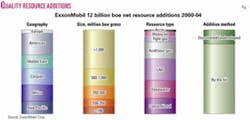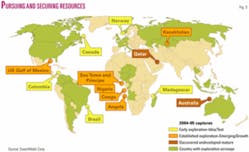ExxonMobil Corp. believes that the world, having produced about 1 trillion bbl of oil, has more than 15 trillion boe remaining, the company’s top exploration official said.
ExxonMobil is focused on adding resources through wildcat drilling and by obtaining access to resources already discovered and which are undeveloped or only partly developed, said Tim Cejka, president, ExxonMobil Exploration Co., Houston.
The company is assessing more than 700 exploration leads in its captured inventory of new opportunities and has screened more than 3,000 discovered/undeveloped opportunities, Cejka told a Lehman Brothers CEO Energy/Power Conference in September 2005.
ExxonMobil, with a remarkable record of sustained exploration success, is “challenging ourselves in every place and every way to improve our performance,” Cejka said.
The US Geological Survey and many competitors share the view that a large global endowment of hydrocarbons remains, he said.
Record of additions
ExxonMobil has added more than 12 billion boe in the past 5 years to the largest resource base of any publicly held oil company (Fig. 1), Cejka noted.
The exploration strategy, to identify and pursue all quality opportunities, is “backed by a corporation which allows us to take advantage of even the unexpected opportunities.
“Implicit in our definition of ‘quality’ is the likelihood of generating industry-leading returns,” Cejka said. The company “is not overly influenced by short-term targets or business cycles,” he added.
Nearly 50% of the resources added in 2000-04 were supergiants, those that exceed 1 billion boe each. More than 90% of the discoveries in which the company has participated are greater than 100 million boe.
“The small remainder of smaller fields are commonly near well-developed infrastructure and very profitable,” Cejka said.
The 80% of resource additions that came through drilling represent 9.8 billion boe of the total 12 billion boe added.
ExxonMobil captured the other 20% in the form of already-discovered resources, such as gas additions from Qatar and higher equity from supergiant Kashagan field in Kazakhstan.
Finding costs plummet
ExxonMobil’s finding cost has fallen to around 44¢/boe in 2004, down 20¢ from 2000.
In the late 1980s, the company’s finding costs averaged $2.75/boe, and that dropped to 80¢/boe in the late 1990s.
Finding costs averaged 58¢/boe in 2000-2004.
“Our business is not barrels; it’s returns,” Cejka said.
The 30% reduction to 44¢/boe “represents a huge efficiency gain and almost $600 million in cost reductions, more than enough to cover the annual exploration budget of some of our competitors,” he said. “Our success rate over the same period has averaged an impressive 50%.”
West Africa deepwater
ExxonMobil acquired its first acreage off Angola in 1992 and by now has participated in almost 21 billion boe of gross resource additions (Fig. 2).
While the company’s first entry was not commercially successful, it later captured acreage along the entire Angolan deepwater margin and is now participating in more than 1 million b/d of gross production there.
“It could not have been done without a long-term approach, selectivity, outstanding people, and a commitment to technology,” Cejka said.
ExxonMobil expected typical wells to have initial production rates of 5,000 to 10,000 b/d, but instead the typical rate exceeds 20,000 b/d.
“As a result of geologic and engineering breakthroughs, our development costs are approximately half of what we estimated in the early ‘90s,” Cejka noted.
Global approach
The global approach ExxonMobil uses to capture the highest quality opportunities builds shareholder value, Cejka said (Fig. 3).
The company prioritizes opportunities through a highly selective, systematic process that is always being updated.
It recruits across the booms and busts of business cycles and hires, trains, and develops the best people.
ExxonMobil maintains online databases that contain more than 100 terabytes of data, five times the storage required for the entire Library of Congress, and the best toolkit in the industry, Cejka said.
“We have a standardized suite of analytical and modeling tools in our global geoscience toolkit comprised of ExxonMobil proprietary applications and vendor work products modified for a uniquely integrated and customized ExxonMobil workflow.
“Whether in an immersive 3D visualization facility or using models to reconstruct plate tectonic configurations hundreds of millions of years ago, we’re always looking for the clues to the next big discovery,” Cejka said.
Global learning systems provide the ability to apply lessons learned from project to project worldwide.
Opportunity pursuit
ExxonMobil’s tracks its global opportunity portfolio as each project advances in maturity (Fig. 4).
For instance, Cejka said, Angola would have been plotted in the Idea/Test category in the mid-90s.
Among recent captures, Madagascar represents a test of new plays while Upper Zakum field off Abu Dhabi, still in negotiations, is a discovered supergiant field in a mature play.
ExxonMobil evaluated acreage off northwestern Madagascar and considered everything from its plate tectonic history to reservoir and source rock distribution using a process called “plates to plays.”
The company is pursuing a play, not a prospect, off Madagascar (OGJ Online, July 20, 2005).
“If we can prove that the play works we will have multiple leads and prospects to pursue,” Cejka said. The 3D seismic survey is complete, and first drilling is due in late 2006-early 2007.
In April 2005, the Abu Dhabi government selected ExxonMobil to negotiate its participation in an opportunity to significantly increase production from Upper Zakum field in the Persian Gulf (OGJ Online, Apr. 7, 2005). The government selected the company in large part because of its technical capabilities.
Upper Zakum, the world’s fourth largest field, is producing more than 500,000 b/d. The project is in final negotiations, Cejka said.✦




